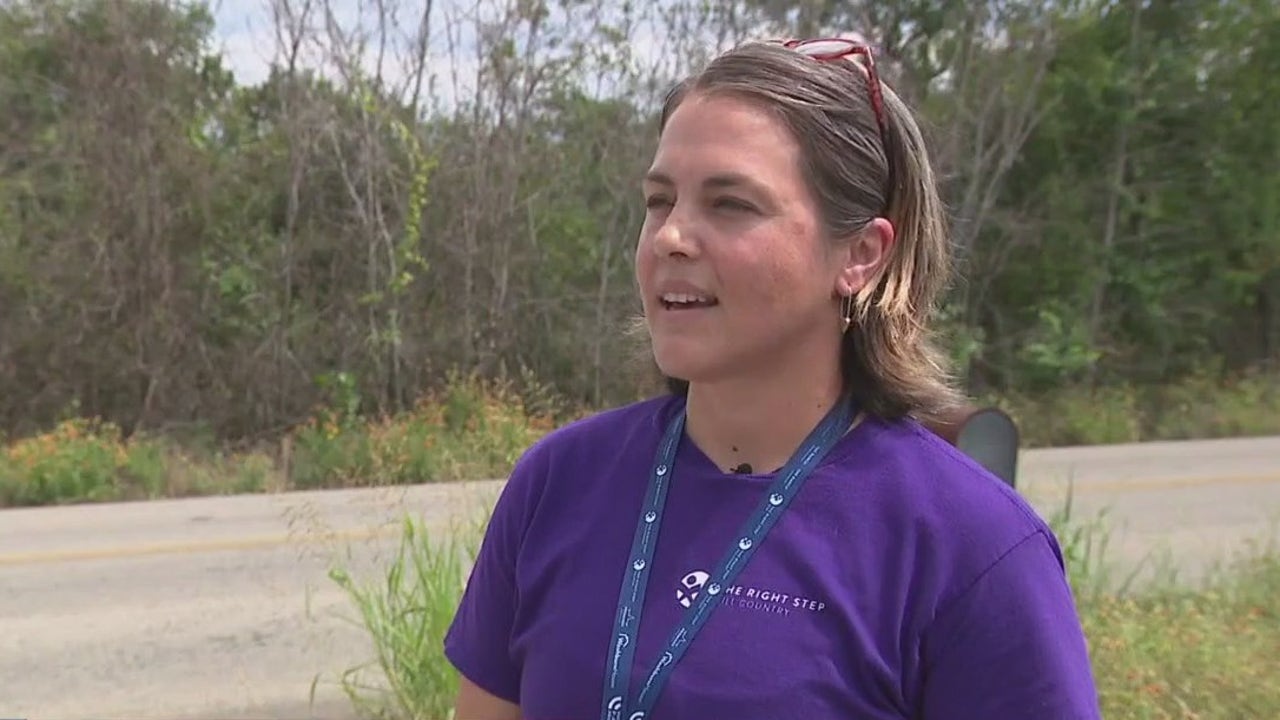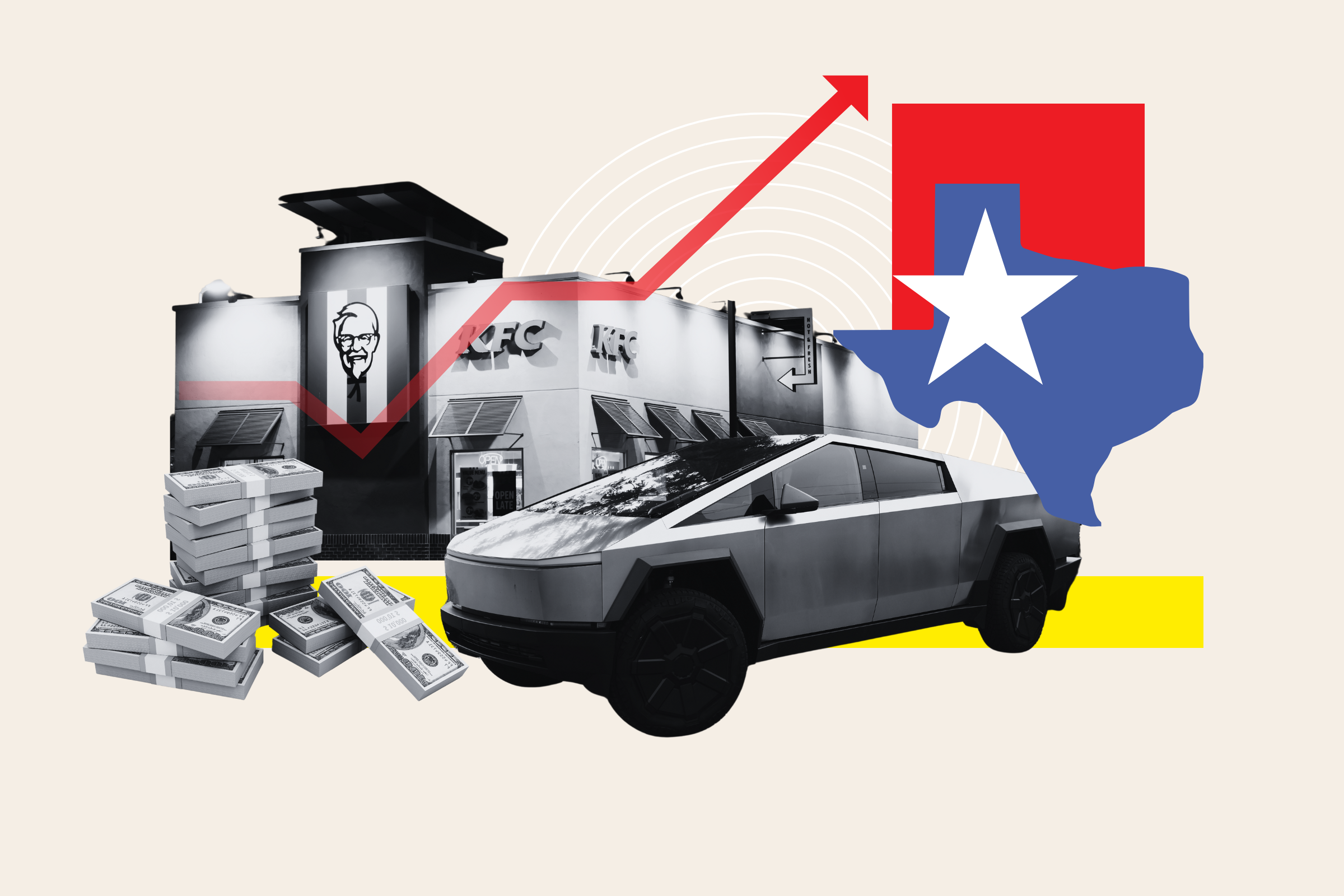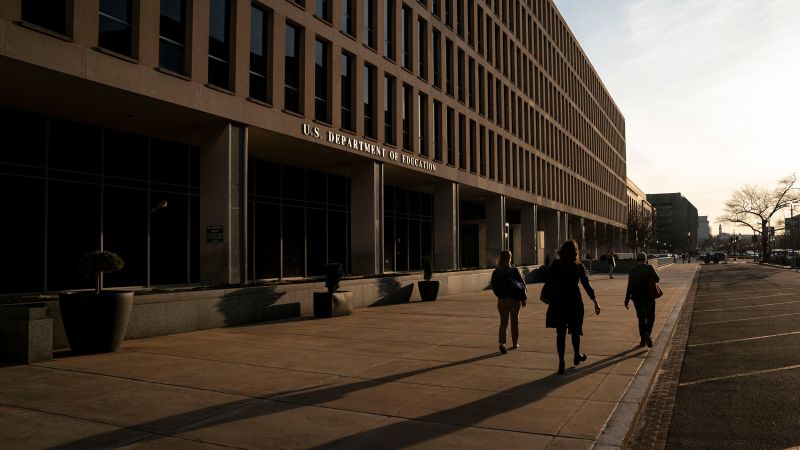Texas
Texas woman credits program for her sobriety after fentanyl overdose

Woman credits program for sobriety
In April 2023, a Hays County woman survived a fentanyl overdose. She was in the throes of an addiction that nearly killed her. Today, she credits a program called Neighborhood Defender Service for her sobriety.
HAYS COUNTY, Texas – In April 2023, a Hays County woman survived a fentanyl overdose. She was in the throes of an addiction that nearly killed her. Today, she credits a program called Neighborhood Defender Service for her sobriety.
Meaghan Callahan said April 26, 2023, is the day that changed her life forever.
“I don’t remember anything except for waking up to the first responders around me and I really had no idea what had happened,” Callahan said.
Callahan had overdosed on fentanyl. EMS administered four doses of Narcan and saved her life.
“When I came to, and I really just got my senses about me, in that jail cell, I was grateful to even be in a jail cell, it gave me a new lease on life,” Callahan said.
Accidental drug overdoses in Travis County
The Travis County Medical Examiner’s Office released its 2023 annual report revealing 279 people died from a fentanyl overdose.
Callahan was in jail and charged with multiple felonies for possession. Police said marijuana was in plain view, and they also found several other types of drugs. Two kids, both under the age of five, were just feet away and were being taken care of by a roommate.
“Children do not deserve to be wrapped up in that world,” Callahan said.
Callahan said she had relapsed. She is a recovering alcoholic and blamed herself, at the time, for trying to get sober alone.
“Even though it was self-medicating, I was trying to treat my alcoholism with the studies that have been done by microdosing ketamine and mushrooms and I felt like that would help me as well as the CBD and cannabis that was found, I thought that that would help me with my postpartum depression to be honest,” Callahan said.
MORE CRIME WATCH STORIES:
It almost cost her her life.
“You can’t really fix yourself; you’ve got to go outside yourself to the community and the professionals to get help,” Callahan said.
Callahan was given that opportunity. She was represented by an attorney with the Neighborhood Defender Service, specifically for Hays County.
“We try to help the client instead of just trying to help the case,” Neighborhood Defender Service Texas Meenu Walters said.
Fentanyl deaths growing in Travis Co.: report
The number of fentanyl-related deaths continues to grow in Travis County, according to the 2023 Medical Examiner’s Report.
NDS staff have been handling about 25 percent of all Hays County cases since 2023. Walters said they use a holistic, team-based model of defense, which includes not only lawyers, but social workers, client advocates, and investigators.
“Something that we can try to work on is building out and identifying community-based options for people so that if we can get in and get people the help that they need outside the system, maybe the system is not what they rely on for help,” Walters said.
“I had a whole team around me to really help me just get better,” Callahan said.
A judge gave her a second chance. All of Callahan’s charges were dropped. She’s now in recovery and wants to help others.
“I want to give hope to the people out there that are in active addiction or love people that know there is a solution and there’s a huge team of us waiting to help,” Callahan said.
She encourages people to ask for help because she said a wonderful life is on the other side.

Texas
Lee Cullum: The Legislature is messing with Texas universities

The Texas Legislature can’t resist getting in on the action. While the administration in Washington has bludgeoned Columbia University into overhauling its Middle Eastern Studies Department, not exactly placing it into “academic receivership” as the White House demanded, but instead folding it into another combination along with South Asian and African Studies, the Senate in Austin is gearing up again for its latest battle with state universities.
Two years ago, Lt. Gov. Dan Patrick tried and failed to eliminate tenure for faculty members in the seven university systems of Texas, settling instead for a version of his Senate bill amended in the House to allow boards of regents to grant tenure. This was already “the case in Texas’ public universities” according to the Texas Tribune. In addition, the measure called for tenured professors to be reviewed every few years, also an accepted practice in American higher education. UT Austin President Jay Hartzell wrote a letter defending tenure, noting that without it recruiting top faculty would be problematic. In the end, the House saved the day, but not without fear taking root.
Those troubles reared again as legislators returned to town this year with Patrick gearing up yet again, this time to give governing boards the power to hire all leaders in their universities, not just the chancellors and presidents. By this time, Hartzell had fled to Southern Methodist University, my alma mater, where trustees respect their presidents and honor their authority.
Now UT Austin, proud flagship of a proud system that includes booming and blooming UT Dallas, must find a new leader, which won’t be easy, especially if the House concurs this time in legislation to give regents, appointed by the governor, decisive power to hire vice presidents, provosts, deans, et al., plus the ability to “vet and veto … courses and curricula” with an eye on preparing students for the workforce, according to the Texas Tribune.
This sounds like the end of the humanities to me and close to the prophecy in The New York Times of a department chair at Columbia that American universities — the envy of the world — would be “really, really more akin to a high school or a local community college.” He was talking about the death of research on campuses, but his point applies to courses directed by political pals/regents as well. It should be noted that Columbia Agonistes has been great for SMU and Texas Christian University. A woman I met at a conference last week said that friends in the East are sending their kids to college in North Texas because of all the upheaval closer to home.
Even so, we’ve been this way in Texas before. In 1971, just 17 years after emerging from censure by the American Association of University Professors, UT Austin lost four professors (supreme stars of the faculty) after a celebrated dean of the College of Arts and Sciences was fired, then was immediately named president of Boston University. He took the others with him. All left lamenting political interference in the work of the university. A regent appointed by Gov. John Connally, by then secretary of the Treasury under Richard Nixon, charged them with teaching too little and living too “high on the hog,” according to the Times.
Thirty years later, Gov. Rick Perry and his henchmen instigated spreadsheets that showed faculty “productivity” in one system and which professors brought in money and which didn’t in another. One proposal was to separate teaching and research budgets, seen by some as anti-research. In a rush of enlightenment, Dan Branch, then a Republican member of the House, managed to pass a bill to create more tier-one public research universities. The governor signed it. Now Texas has more tier-one universities than any other state in the Union.
Why jeopardize all that? Why aren’t Texas alumni, usually fanatical, rising up in defense of the Longhorns and their fantastic legacy in learning as well as linemen? Usually university presidents such as Jay Hartzell or Gerald Turner, whom Hartzell will follow at SMU, are masters at keeping their blockers with them.
Chances are that’s harder now because the turmoil in the Texas Legislature is reflecting a national mood of disenchantment with higher education. What bothers critics most, I suspect, is what they perceive as a leftward tilt among college professors. However, those professors may not have as much influence as some parents fear. In last year’s election, Kamala Harris won voters ages 18 to 29 by four percentage points where in 2020, this group favored Joe Biden over Donald Trump by 25 percentage points, according to the Center for Information and Research on Civic Learning and Engagement.
I just had lunch with a sophomore major in political science at SMU who seemed more than able to measure her choices at the polls and in life. She had to leave early for her class on Northern Irish history. Does her professor mention the brutal, bloody 30 years of troubles? I hope so.
Lee Cullum is a Dallas journalist and former host of CEO on KERA TV.
We welcome your thoughts in a letter to the editor. See the guidelines and submit your letter here. If you have problems with the form, you can submit via email at letters@dallasnews.com
Texas
Unpacking Future Packers: No. 29, Texas DT Alfred Collins

The Unpacking Future Packers Countdown is a countdown of 100 prospects who the Green Bay Packers could select in the 2025 NFL draft.
The Green Bay Packers’ run defense took a step forward under first-year defensive coordinator Jeff Hafley. This past season they gave up four yards per carry and 1,689 yards, which ranked seventh in the league.
If the Packers want to continue to shut things down between the tackles, a player they could target in the 2025 NFL Draft is Alfred Collins. The Texas defensive tackle checks in at No. 29 in the Unpacking Future Packers Countdown.
A native of Texas, Collins recorded two tackles for loss, one sack, one interception and knocked down three passes during his first season on campus. In 2021, Collins recorded five tackles for loss and two sacks. The following season he recorded three tackles for loss and one sack. In 2023, Collins recorded two sacks.
This past season, Collins recorded a career high of 55 tackles and six tackles for loss. The Texas defensive tackle also recorded one sack and knocked down seven passes.
“Collins was the anchor of one of the nation’s best run defense just one year after losing two defensive tackles to the NFL draft,” Evan Vieth, a writer for Inside Texas, said. “He led a five-deep defensive tackle group in snaps and was a huge body in both the A and B gaps. I’d argue he was the second most impactful on the defense because of his ability to stuff the run on a team that prioritized pass rushers in the front seven and ball-playing defensive backs on the back end.”
Collins is a well-put-together interior defensive lineman. He checked in at the combine at 6-6, 332 pounds, with over 34-inch arms. He’s a tank in the middle of the line and is able to shut down running lanes.
He has a lot of power flowing through those long arms. The former five-star recruit uses his length to help him out-leverage at the point of attack. He’s able to discard blockers with his bully strength and strong hands. With his massive frame, he’s able to bear down against double teams. The Texas defensive tackle has the lateral quickness and nimble feet to slither into gaps and stop run plays before they can get started. He has the range to make plays tackle-to-tackle. According to Pro Football Focus, he recorded 27 run stops this past season. A team will draft him for his ability to two-gap and keep linebackers clean.
“Collins is a giant player in the box but it doesn’t look like it you turn on the tape,” Vieth said. “It’s because a lot of his weight is pure muscle, so he is lean enough to slither through block sheds and has the foot speed to move laterally. He’s a smart kid of course, but his strength and foot speed are pretty absurd. It’s why he was a five-star recruit.”
Collin has a surprisingly quick first step and charges upfield with power. With his strength, he can walk offensive lineman back into the quarterback’s lap. When he is unable to get home, he has a knack for getting his long arms up to muddy up passing lanes (nine pass deflections over the past two seasons). He recorded 18 pressures this past season and 23 in 2023.
“If there’s one passing down strength, he has it’s getting his arms in the way of passes and batting them down, or obscuring the quarterback’s vision,” Vieth said. “He can bull rush, but so can any 330-pound NFL defensive tackles.”
Fit with the Packers
The Packers need to replace TJ Slaton and with his size and ability to clog up running lanes, Collins could be an ideal target.
Collins has a powerful, NFL-ready frame. His trump card is his ability to two-gap and keep linebackers like Edgerrin Cooper and Quay Walker clean.
“I wouldn’t draft him if my No. 1 need was a pass rusher, but he is the kind of player that plays into three contracts in the NFL,” Vieth said. “Sturdy, athletic and smart are the three words that come to mind. The NFL is slowly evolving back into the running game as a counter to lighter boxes, so having a two-down defensive tackle who can single-handedly blow up plays is becoming more and more valuable.”
Drafting a player like Collins may not have fans running to the Packers Pro Shop to buy his jersey this summer, but when the calendar flips to November, he’d quickly become a fan favorite for his ability to do the dirty work in the trenches and shut down running lanes.
Collins is a plug-and-play two-down defender early in his career. Anything he offers as an interior pass rusher would be gravy. With his ability to muddy things up against the run, Collins could have a place in Green Bay’s interior rotation.
Texas
The Texas business boom

Texas has seen an economic boom over the past few years with gross domestic product (GDP) growth rates significantly outpacing the U.S. average, while a string of major corporations have announced they are moving their corporate headquarters to, or investing heavily in, the Lone Star State.
Speaking to Newsweek, several experts on the Texan economy or politics attributed this primarily to low taxation and business-friendly regulations. However, two warned there could be a future clash between corporate interests and the social conservatism of Texas Republicans who control both chambers of the state legislature as well as the governor’s office.
Business Investment
On February 18, KFC, the fast-food giant formerly known as Kentucky Fried Chicken, became the latest company to announce they are moving their headquarters from Louisville, Kentucky, to Texas choosing Plano, a city on the northern outskirts of Dallas. Speaking to Newsweek, David Gibbs, chief executive officer of KFC’s parent company Yum! Brands, said the move would “position us for sustainable growth” and “help us better serve our customers, employees, franchisees and shareholders.”
Earlier in February, real estate listing website Realtor.com announced it was transferring its corporate headquarters from Santa Clara, California, to Austin, with the company telling Newsweek the city would become “its top hiring location.”
In July 2024, billionaire Elon Musk announced he was moving the headquarters of X, formerly Twitter, and SpaceX to Texas in response to California Governor Gavin Newsom approving a move that stopped teachers being required to inform parents if their children change their gender identity.
In an X post, Musk wrote: “This is the final straw. Because of this law and many others that preceded it, attacking both families and companies, SpaceX will now move its HQ from Hawthorne, California to Starbase, Texas.”
Musk is now a close ally to President Donald Trump and heads up the recently formed Department of Government Efficiency (DOGE).
Financial services company Charles Schwab Corp. was based in San Francisco until 2021 when it shifted its headquarters to Westlake, Texas. In August 2024, oil giant Chevron announced it was moving its headquarters from San Ramon, California, to Houston.
Earlier this month, Apple announced it will build a new 250,000-square-foot manufacturing facility in Houston to support its “personal intelligence system” as part of a wider $500 billion investment across the U.S.
Texas’ plentiful land and relatively cheap energy have also made it a favored location for the large data centers used to power artificial intelligence (AI). In January, Trump announced Stargate, a combined $500 billion venture involving OpenAI, Oracle and SoftBank, which will be centered around the Lone Star State.
Texas Predicted to Be Biggest U.S. State by 2045
According to figures from the Texas Comptroller’s Office in 2024, the Texan economy grew by 4.8 percent, double the 2.4 percent that Commerce Department data shows was achieved by the nation as a whole.
U.S. Census Bureau figures show that between July 2023 and July 2024 the population of Texas rose by 562,941, with new residents attracted by the availability of work and low taxation. This gave Texas an annualized growth rate of 1.8 percent, the third highest in the U.S. behind Florida and the District of Columbia.
A report released by Realtor.com in February concluded that in 2045 Texas’ population will have surged by 35 percent to 42 million, up from the current 31 million, and would replace California as the most populous state.
Photo-illustration by Newsweek/Getty
Taxation and Regulations
Texas is just one of nine states across the U.S. that doesn’t charge any income tax on individuals or companies below a certain revenue ceiling, while its business tax rate is low and falls to zero for companies below a certain threshold.
According to a 2024 study published by Realtor.com, Texas accounted for 15 percent of new housing permits issued across the U.S., despite only making up 9 percent of its population, helping to keep prices and rents relatively cheap despite the rapid inflow of people.
Professor Benjamin Powell, an economist who teaches at Texas Tech University, attributed the state’s thriving economy to a comparatively low cost-of-living, low taxes and less stringent regulation.
“Companies are fleeing high tax, high regulation, high cost states like California, New York, and Illinois,” he told Newsweek. “They are attracted to Texas because we have lower taxes and regulation, and their workers face a lower cost-of-living here than in those other states.”
Professor Jon Taylor, a state politics expert who teaches at the University of Texas at San Antonio, agreed with this assessment, telling Newsweek: “The governor regularly preaches that corporations are relocating or building new capacity would tell you that it’s because of the so-called ‘The Texas Miracle,’ which drives perceptions that we’re a business-friendly state. He’s not wrong about the business-friendly part. We are.”
He continued: “We can rattle off the usual bullet points about a strong economy with no state income tax, relatively minimal business regulations (particularly for limited liability companies), a burgeoning talent pool created a number of world class research universities, and a leader in energy, space exploration, artificial intelligence, and tech manufacturing. Those bullet points have convinced a number of large corporations to relocate or develop facilities in Texas during the past decade or more.”
Joshua Blank, who heads the Texas Politics Project at the University of Texas at Austin, told Newsweek: “Texas politicians are pretty consistent, and aggressive about branding Texas as a pro-business state. And after over 20 years of Republican control, the rhetoric’s been followed with years of legislative and executive actions that are directly intended to be friendly to business.”
In a statement provided to Newsweek, Andrew Mahaleris, Texas Governor Greg Abbott’s press secretary, said: “Companies keep moving here because in Texas, we move at the speed of business by cutting red tape and protecting industry from harsh job-killing restrictions and unnecessary regulations that can burden innovators elsewhere.
“Texas is the 8th largest economy in the world and the economic engine of the nation, leading all states for jobs added over the last 12 months(…)
“Texas remains number one because people and businesses are choosing our state over any other for the unmatched competitive advantages we offer: no corporate or personal income taxes, a predictable regulatory climate, and a young, skilled, diverse and growing workforce.”
Political Concerns
Taylor warned of a potential upcoming clash between the values of companies moving to Texas for business reasons and the state’s social conservatism.
Referring to states making the move, he said: “Question is whether they’re comfortable moving to Texas and investing long-term given issues such as the state’s draconian reproductive choice laws, limits on voting accessibility, dismantling diversity, equity, and inclusion policies, attacks on environmental, social, and governance standards, and harsh immigration policies.”
This question was also raised by Blank, though he was more optimistic on the outcome.
“As more companies, and especially more high-tech companies, move to Texas, it does raise the question of whether Texas’ conservative politics will clash with a potentially less conservative workforce,” he said. “So far, Texas’ politics hasn’t led companies to reconsider their decisions, and it doesn’t seem likely to in the future.”
Powell said that many of those moving to Texas actually share the state’s dominant values.
“Some Texans worry that these interstate migrants will bring their liberal values and politics with them to Texas, but the opposite seems to be the case,” he said. “The Californians leaving for Texas often share more political values with Texans than they do with other Californians.”
-

 News1 week ago
News1 week agoHow a Major Democratic Law Firm Ended Up Bowing to Trump
-

 Education1 week ago
Education1 week agoICE Tells a Cornell Student Activist to Turn Himself In
-

 News1 week ago
News1 week agoDismantling the Department of Education will strip resources from disabled children, parents and advocates say | CNN
-

 News6 days ago
News6 days agoWashington Bends to RFK Jr.’s ‘MAHA’ Agenda on Measles, Baby Formula and French Fries
-

 News5 days ago
News5 days agoTrump Is Trying to Gain More Power Over Elections. Is His Effort Legal?
-

 Politics1 week ago
Politics1 week agoEXCLUSIVE: Groundbreaking new prayer book designed for demographic most targeted for abortion
-

 Movie Reviews1 week ago
Movie Reviews1 week agoFilm Review: Rachel Zegler is the Best Part of an Otherwise Dull Remake of ‘Snow White’ – Awards Radar
-

 News1 week ago
News1 week agoShooting at Park in New Mexico Leaves at At Least 3 Dead and 16 Injured




















